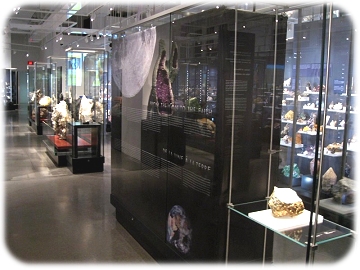

|
Terrestrial History
|
||||
 |
This celestial masterpiece lay undisturbed for eons deep in the world�s largest and hottest desert, the Sahara, until it was discovered by some very fortunate hunters of treasure in July of 2007. The meteorite was provided to the famous Hupé Collection after lengthy negotiations. The Hupé Collection is known for possessing the world�s most complete and notable assemblage of planetary main masses. Some may ask "Why all of the fuss, aren�t we |
|||
|
quietly studied at the University of Washington where it was given the informal name "The Rock" because its immense posture commanded more than
just the next number in a sequence. There was no mistaking what rock was being referred to in the laboratories when using this moniker.
Scientists were permitted to select their own type specimen, and a repository amount of 40 grams was committed in
advance of the honorific official name Northwest Africa 5000 being assigned by the international Meteoritical Society.
Washington University in St. Louis and the Carnegie Institution in Washington D.C. soon provided additional
confirmation of its lunar provenance by way of specific bulk elemental analysis and oxygen isotope testing. Several
more laboratories including Berkeley Geochronology Center, Berkeley Space Sciences Laboratory, Purdue University,
ETH-Zurich, University of Arizona, Lawrence Livermore National Laboratory, and National High Magnetic Field
Laboratory at Florida State University have helped to translate the extraterrestrial history of this exceeding rare meteorite from the Moon. |
||||
| "A diamond
is also just a rock but nowhere near as rare, complex or scientifically important as a rock from our nearest celestial neighbor, the Moon." |
||||
| Preparation posed its own set of challenges. It is understandable how nervous a diamond cutter must feel when confronted with the task of cutting the big one. Even though in the past, we have prepared well over 25,000 meteorite slices, the entire team lost sleep over this one, having never cut something this valuable before. Only after studying a very accurate casting for weeks and crunching the numbers was our group able to put together a cutting plan. The decision was made to withhold an end-cut large enough to hopefully satisfy the collector market, yield the world�s largest complete lunar slice, and maintain an impressive main mass for display purposes. This would require a flawless execution since the tolerances were within a few millimeters of reaching our preset limits. After careful consideration, a more rigid, precision diamond lapidary saw was chosen to perform the main cuts |  |
|||
|
even though cutting losses would be great. The freshly balanced, calibrated and sterile saw performed flawlessly, leaving no
tell-tale cutting marks on the main mass. The flat surface (referred to as a window) was then lightly polished by
hand using diamond grit. Most would agree that the end product is the best in the universe. |
||||
| "If this rock were brought back from the Moon by astronauts, its proportionate cost would be enormous..." |
||||
|
Some may ask "Why all of the fuss, aren�t we just talking about a rock?" Our answer is simple, "A diamond
is also just a rock but nowhere near as rare, complex or scientifically important as a rock from our nearest celestial
neighbor, the Moon." If this rock were brought back from the Moon by astronauts, its proportionate cost would be
enormous, much more than that of flawless diamonds. On the other hand, natural processes brought this rock from the Moon
here to Earth. An asteroid strike on the Moon caused the ejection of this meteorite into an Earth-crossing orbit, which
is a much less expensive yet time consuming process. |
||||
 |
This meteorite made its public debut at the Royal Ontario Museum from December 20th 2008 to April 15th 2009. This is the largest lunar meteorite ever to be placed on public display. It was prominently exhibited in its own 11 by 8 by 2 feet display at the very front and center for the grand opening of the new Teck Suite of Galleries: Earth�s Treasures. It was intensely popular as patrons viewed it both on the way in and once again upon exiting. An insurance value of $9,610,000.00 was set far below its conservative appraised value of $15,376,000.00 when the main mass weighed 9,610 grams. |